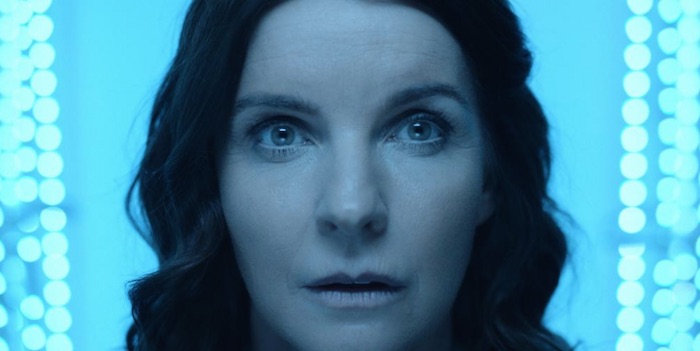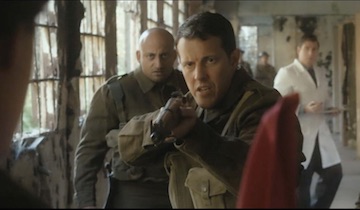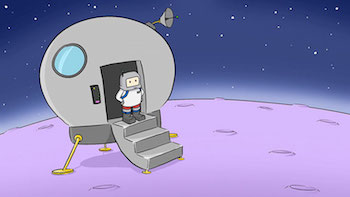2017 SYDNEY FILM FESTIVAL: The vast, magnificent country of Canada’s Northwest Territories is home to the Gwich’in people, an indigenous population whose relationship with the flora and fauna of the unforgiving landscape dates back many centuries. In The Sun at Midnight, director Kirsten Carthew utilises the backdrop of the land and its people to tell a deeply affecting coming-of-age tale, in which a teenage girl of Gwich’in ancestry (played by Devery Jacobs) must reconnect with her heritage to survive in the Arctic Circle wilderness. “Immersion in nature supports self-discovery and mental wellness,” says Carthew, whose semi-autobiographical narrative and stunning imagery represents a remarkable debut feature. Ahead of her film’s Australian premiere at the Sydney Film Festival, Kirsten Carthew (pictured, below) spoke with SCREEN-SPACE from Berlin, where she is accompanying the film on its international festival rollout…

SCREEN-SPACE: It is such a unique premise for a film - the archetypal teenage coming-of-age story, but one melded with a survival drama. What inspired the narrative?
CARTHEW: The story comes from my own life, growing up as a teenager, feeling like a fish out of water, dealing with an intimate personal loss. I have moved locations many times and have always found solace and comfort in nature. Anyone who has suffered loss or felt disconnection can relate to the personal journeys of Lia and Alfred. These are the personal themes and they are universal, because as people we are so similar in our wants and needs. Additionally, themes relating to the need for greater environmental stewardship and the importance of connectivity with nature can be embraced by universal audiences, and told in The Sun At Midnight through specific references to champion protection for caribou populations, as well as for the lands and waters in the Arctic and Subarctic regions.
 SCREEN-SPACE: I don't imagine the people of Fort MacPherson see a lot of film industry types. How willing and accepting of you and your crew were the population? What did you need to convey about them to ensure authenticity?
SCREEN-SPACE: I don't imagine the people of Fort MacPherson see a lot of film industry types. How willing and accepting of you and your crew were the population? What did you need to convey about them to ensure authenticity?
CARTHEW: The Sun At Midnight is the first feature film from Canada’s Northwest Territories. I am from a township there called Yellowknife. A feature film shoot was a new experience for Ft. McPherson, which is located at the Arctic Circle and has a population of 750 people. In 2009, I approached the Gwich’in Social and Cultural Institute; they shared an earlier draft of the script with elders and community members, who gave great feedback and decided to collaborate. Their participation was essential to both the story’s authenticity and the realization of the film. It took us six years to secure financing and our Gwich’in partners actively supported and contributed to the project throughout. The film was only made possible with the participation of the community of Ft. McPherson and the Gwich’in Tribal Council, who helped crew the film with locals. We held the premiere at the high school gym and had a feast for community members, who were thrilled to see people they knew on screen. The Sun At Midnight is the first film to feature Gwich’in characters, land and values and Indigenous audiences and fans of Indigenous cinema have embraced the film. We are proud of our collaboration and relationship and continued support for the film. (Pictured, above; Devery Jacobs as Lia)
 SCREEN-SPACE: Your leading lady, Devery Jacobs, is such a compelling screen presence; visually, of course, but also a personality that evokes both teenage angst and an 'old soul' spirit...
SCREEN-SPACE: Your leading lady, Devery Jacobs, is such a compelling screen presence; visually, of course, but also a personality that evokes both teenage angst and an 'old soul' spirit...
CARTHEW: I was immediately struck by Devery’s screen presence during her auditions. ‘Compelling’ is exactly right. Devery is the ideal collaborator, a total pro whose acting process includes in-depth character analysis and mindful reflection. She invested fully in the role and it was easy to trust Devery to embody the role of Lia. Once Devery was cast in the role, there were some aspects of Lia’s character that organically changed now that we were co-creating the story. I loved working with Devery and value how invested, professional and just truly exceptional she is. (Pictured, above; Duane Howard as Alfred)
SCREEN-SPACE: Lia's growing respect for and unlikely friendship with Alfred is the heart of your story. How did you, Devery and the wonderful Duane Howard create the chemistry and balance in their story?
CARTHEW: We had a tight shooting schedule and little rehearsal time. I did my best to organize the shoot chronologically so that the real life relationship between Devery and Duane would develop in line with the on-screen relationship of their characters, Lia and Alfred. It was important for the performance to drive the camera-action, which meant that the camera would follow the actors’ lead. To this end, I worked alone with the actors on set to feel out the scenes before the key crew was invited to watch. I also gave the actors alone time on set before key scenes so they could be as present with each other as possible. Devery and Duane also genuinely connected and developed a friendship as individuals, which was great. I think part of their on-screen chemistry reflects their genuine respect and care for each other.
 SCREEN-SPACE: It looks to have been a physically demanding shoot, utilising locations that have been largely unseen by film cameras. What disciplines did you and your production have to master to adapt to the conditions?
SCREEN-SPACE: It looks to have been a physically demanding shoot, utilising locations that have been largely unseen by film cameras. What disciplines did you and your production have to master to adapt to the conditions?
CARTHEW: Over 90% of the film was shot outdoors. That’s a huge challenge because regardless of budget or location, you operate at the whim of the weather. We shot at a time of the year that should have provided the ideal filming conditions but that definitely was not the case. Instead, we experienced temperatures ranging from -5 to +22 Celsius and rain, fog, snow and sunshine. We filmed the “in town” scenes first, when it was sunny and 22 degrees. Then, just a week later, when we started to shoot the outdoor scenes, the temperature dropped to below zero and all of our locations were suddenly under two feet of snow! We didn’t have any choice but to continue filming and incorporate the snow into the film. We had to scout new locations everyday and move quickly to stay warm, but also move more slowly to accommodate so many new technical and logistical challenges. Devery and Duane were total troopers and handled the cold with total grace. The crew was often wet, cold and, by virtue of our location along the Arctic Circle highway, forced to suck up the discomfort and plough through. We have several “war stories” from the shoot, which were a little painful at the time, but now bring us together and we laugh at! (Pictured, above; Carthew, far left, on-location with her actors)
THE SUN AT MIDNIGHT screens Sunday June 11 and Saturday June 17 at the Sydney Film Festival. Further ticketing and session information can be found at the event’s official website.






































































